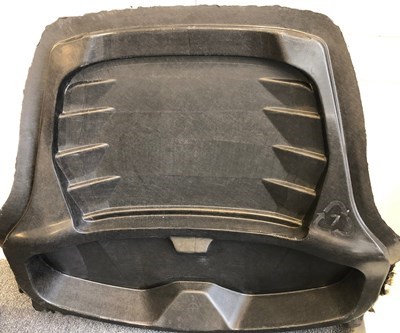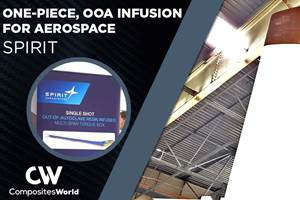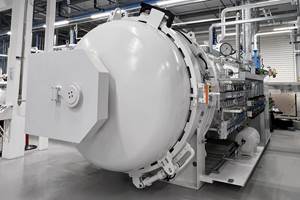Episode 29: John McQuilliam, Prodrive Composites
Prodrive Composite’s John McQuilliam discusses the company’s primary to tertiary (P2T) carbon fiber composite recycling process.
Prodrive Composite’s John McQuillam discusses the company’s primary to tertiary (P2T) carbon fiber composite recycling process.

Example of a tertiary part produced using ProDrive’s P2T process. CW photo | Scott Francis
In this episode of CWTalks, CW senior editor Scott Francis interviews John McQuilliam, chief engineer at Prodrive Composites (Milton Keynes, U.K.), designer and manufacturer of advanced lightweight composites for a wide range of applications including automotive, motorsport, aerospace, marine, defense and other specialist sectors.
John is a Formula One car designer from the UK who has worked with numerous motorsports companies. He joined Prodrive in 2017 as the chief engineer of their composites division. John discusses the company’s primary to tertiary (P2T) process, which the company says simplifies recycling and gives composite material the potential to fulfil three or more useful lifetimes.
You can listen to the full CW Talks interview above or visit:
Excerpt from the episode
CW: Hi, John, and welcome to CW talks, the composites podcast. Back in March, I believe it was, I visited Prodrive Composites and got to see a little bit of your P2T process, which stands for primary to tertiary.
JM: That’s right. The first stage is the manufacture of the primary component, and that is what the majority of the work we currently do. So these are parts that require virgin fibers a specialty resin or particular type of thermosetting resin for whatever reason. So they’re what I would call traditional composite parts ... they’re parts that we wouldn’t particularly change the design of or the manufacture of, but we would certainly change them to make them more readily recyclable.
CW: Okay. And those are typically the more high performance kind of part?
JM: Yes. So they would be made out thermoset … What we would do is simply change the design of them to allow the waste material from making the parts and ultimately the part of the end of its life to be recyclable so that we can reuse the carbon fibers contained within those parts. So the thermoplastic is comes in in the second stage ... the initial stages can be thermoset or thermoplastic, but the important thing is that it allows us to reclaim the fibers. So to reclaim the fibers from the primary parts, as touched on, we certainly change the design materials to something that is easier to reclaim the fibers from, so what we’re really talking about is an increased use of non-crimp fabrics, more unidirectional materials, things where the production waste and the component when they go through for the fiber reclaiming process will give a better yield of longer high-quality fibers.
CW: Can you describe a little bit of the reclaiming process that happens for that primary component and then what characterizes the resulting secondary part?
JM: Yes. So the recycling or the reclaiming process for the primary parts is a an incineration type process. So the waste prepreg — the offcuts prepreg — or the end of life parts go into a furnace and all of the resin is burned off leaving the carbon fibers behind. And those carbon fibers through a series of processes are turned into a non-woven mat of consistent thickness and random orientation — so it ends up being able to make a quasi-isotopic plaque.
CW: Is this the process that ELG [ELG Carbon Fibre] is doing for you? Are they handling the pyrolysis?
JM: Yes, ELG do that portion of it. So, we send them our waste offcuts and some component parts and then they turn it back into the into one of the precursors, one of the parts that we use to make our secondary parts.
CW: Can you tell me a little bit about those secondary parts and what characterizes them?
JM: So, the secondary parts, the reinforcement is mainly made out of the reclaimed carbon fibers with a discrete use of virgin fibers if required in certain areas. But the majority of the reinforcing is reclaimed fibers. And then we introduce a reactive thermoplastic. So, this is a liquid resin that we, shall we say, infuse the reinforcements with. Then there’s a curing type of process and we get a finished component and its process is done at relatively low temperatures, atmospheric pressure and we get a good component made that way.
CW: Part of what enables P2T is this this resin system that you’ve described as a “reactive thermal plastic resin.” Can you explain a little bit more for our listeners what what you mean by that?
JM: So reactive thermoplastic in some ways is very similar to a thermosetting resin. So we mix it up immediately before making the component. And there's two or three liquid components going to the mixture. Each of those is a liquid. And when they combine with time and a little bit of temperature, they actually polymerize into a true thermoplastic. And it’s the thermoplastic properties that allow subsequent recycling. And advantage of it being a reactive thermoplastic rather than a traditional thermoplastic is the fact that we’re effectively creating a thermoplastic at the same time we’re surrounding the reinforcing fibers is that it is very low viscosity so it can be formed in normal traditional, should we say, thermosetting type processes. It doesn’t need the high temperature and the high pressures that you will get with either injecting a molten thermoplastic into a fiber preform or taking a thermoplastic prepreg where the thermoplastic and the fibers have already been combined and then remounting them at high temperature and pressure, typically in metallic molds. So we’re avoiding the complexity and cost of the mold tools required to process thermoplastics above the melt point and avoiding the difficulties due to the high viscosity of molten thermoplastic with distortion and movement of the reinforcing within the mold cavity.
CW: And I’m guessing that translates into cost savings, time savings and basically means quite a bit for the production...
JM: You’ve got it, yes. So the production method is akin to what we do in traditional thermosetting industry, but the tooling cost is way lower than will be required for processing a traditional thermoplastic. And that’s a big advantage for most of our customers. You don’t want to make the upfront investment in thermoplastic mold tools — or mold tools simply for thermoplastics.
CW: So are you seeing this as an enabler for more high-volume production?
JM: Certainly, we believe it is an enabler for higher production. Cycle times can be shorter than their traditional thermosetting in it doesn’t require a ramp up to a processing temperature, a dwell and then a cool down again before you can turn around the mold. So we’re seeing rate advantages by using this process compared to our traditional oven or autoclave cured components.
CW: And of course, one of the exciting things is that from there, you can recycle this secondary part yet again. So what characterizes this tertiary part in the life cycle of this material?
JM: So I’d say the secondary part, being a true thermoplastic, can be reformed into other shapes and typically would be cut up into into small pieces, and then put into the cavity between heating mold and pressed into a new shape. So there will be a possibility to take all of the redundant secondary parts, all of the production waste from the secondary parts, and reforming them into another fiber reinforced plastic component or fiber reinforced polymer component.
CW: And from there, these tertiary parts aren’t necessarily the end of the road for that material, even at that...
JM: That’s correct... So we think that these tertiary parts, because they’re thermoplastic, can be reformed, almost an infinite number of times. The process of cutting them up into molding palettes, should we say molding pieces, does have an attritional rate on the fiber… so some of the mechanical properties would drop, but other mechanical properties such as the stiffness, the thermal expansion rate and the distortion temperature would pretty well be retained. So you still get a high quality fiber reinforced component — not with the original strength of continuous fiber component or even a relatively long fiber component — but certainly there’s still the advantages in terms of stiffness, thermal expansion and the distortion temperature that makes it very worthwhile reprocessing the tertiary parts time time again.
Related Content
VIDEO: One-Piece, OOA Infusion for Aerospace Composites
Tier-1 aerostructures manufacturer Spirit AeroSystems developed an out-of-autoclave (OOA), one-shot resin infusion process to reduce weight, labor and fasteners for a multi-spar aircraft torque box.
Read MorePEEK vs. PEKK vs. PAEK and continuous compression molding
Suppliers of thermoplastics and carbon fiber chime in regarding PEEK vs. PEKK, and now PAEK, as well as in-situ consolidation — the supply chain for thermoplastic tape composites continues to evolve.
Read MoreComposites manufacturing for general aviation aircraft
General aviation, certified and experimental, has increasingly embraced composites over the decades, a path further driven by leveraged innovation in materials and processes and the evolving AAM market.
Read MoreBusch expands autoclave solutions
Busch announces its ability to address all autoclave, oven and associated composites manufacturing requirements following the acquisition of Vacuum Furnace Engineering.
Read MoreRead Next
CW’s 2024 Top Shops survey offers new approach to benchmarking
Respondents that complete the survey by April 30, 2024, have the chance to be recognized as an honoree.
Read MoreComposites end markets: Energy (2024)
Composites are used widely in oil/gas, wind and other renewable energy applications. Despite market challenges, growth potential and innovation for composites continue.
Read MoreFrom the CW Archives: The tale of the thermoplastic cryotank
In 2006, guest columnist Bob Hartunian related the story of his efforts two decades prior, while at McDonnell Douglas, to develop a thermoplastic composite crytank for hydrogen storage. He learned a lot of lessons.
Read More

















.jpg;maxWidth=300;quality=90)










